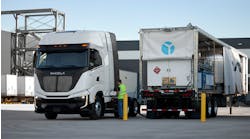Battery-electric trucks are expected to have significantly less maintenance than the diesels they replace. CALSTART recently estimated there were 1,215 zero emission trucks (Class 2B through Class 8) deployed in industry at the end of 2021. Some of these are prototypes or early production vehicles. CALSTART also estimates there are at least 140,000 zero emission trucks on order.
These numbers highlight that: No. 1, there is not much production field experience with maintaining these vehicles, and No. 2, there is a lot of hope that they will live up to their potential of reducing maintenance and operating costs.
Battery electric vehicles (BEVs) have significantly fewer moving parts. The friction inherent in moving parts produces wear, heat, vibration, and noise—all major contributing factors to part failures. The moving parts that remain on BEVs, like friction brakes, also see significantly less wear because of regenerative braking. Electric motors have had a century or more of refinement in harsh environments. They likely are not going to be maintenance issues either.
The promised reduction in maintenance of BEVs is anywhere from one-half to one-third of what is required for a diesel-powered truck. But the production-level BEVs that fleets will begin purchasing this year are still early in their maturity, so a learning curve is likely and to be expected. That learning curve may be moderated by the experience being gained by component suppliers in the automotive and bus markets where there are several million EVs, with some operating for over a decade.
Upping uptime with good data
Uptime also needs to be considered in the maintenance discussion. Fleets operating the new BEVs will need to keep good records of both maintenance costs and uptime. As the products mature over the next few years, fleets will need to validate that maintenance costs are actually being reduced and that uptime is improving.
Maintenance costs and uptime are intertwined. BEVs have significantly more software and computer hardware than diesels. Troubleshooting software problems may not appear as a significant cost, but if the vehicle is down for extended periods while the problems are investigated, the cost of that downtime to the fleet in terms of lost revenue needs to be considered.
BEVs have a significant number of sensors supplying data to the software and computers. Sensors are traditionally an opportunity area for problems. Sensors may be working fine, they may be sending erroneous signals, or they may not be sending any signals at all. Combinations of sensor readings may be presenting conflicting information. Fleets and OEMs will need to develop robust and rapid methods to localize issues on the vehicles.
Over-the-air (OTA) updates are expected to help reduce maintenance costs and downtime. Once one truck’s software problem is identified and resolved, all similar trucks can be updated in the field through OTA systems—without taking them into a maintenance shop. There will still be hands-on work needed on BEVs, but OTA software updates should reduce the number of shop visits.
High-voltage systems on BEVs will require special training and strict adherence to lock-out/tag out procedures, proper use of insulated gloves, and other safety protocols. In general, early adopter fleets will not have their own on-staff experts in high-voltage systems. Instead, they will rely on the OEMs to provide expert service technicians. This will be a challenge as more production level BEVs get into fleets since the pool of expert high voltage technicians is just starting to form. In the case of one OEM, a local technician was provided who had to service three customers in one city. Delays could occur if all three customers had issues at the same time. This situation should improve in time—both with more trained technicians joining the work pool and as larger fleets bring maintenance in-house.
Part availability for early production vehicles creates an ever-present risk. In light of the overall supply chain challenges faced in the last year, this is even more so impactful. This may create challenges for fleets running BEVs, as certain systems, such as the battery module, likely will be replaced, not serviced. The failed units will likely be shipped back to their suppliers or OEMs, and new ones installed. There likely will be options to use factory-refurbished units as well. Rapidly locating and delivering service parts will be a challenge during the early years of BEV use.
Fluid handling and disposal is much easier with BEVs. While BEVs will still have some fluids, there will be no diesel, minimal oil lubricants, no diesel exhaust fluid, some coolants, washer fluids, and air conditioning refrigerant. There are no fumes to manage, so BEVs will not need complex shop venting systems to avoid ignition of vapors. This means that shop building maintenance and operating costs will also be reduced with BEVs.
There will also be substantial changes to the HVAC, cooling (for traction motors and electronics), compressed air, and hydraulic systems (such as power steering) on BEVs compared to today’s diesel-powered vehicles. In addition, BEVs will have traction battery heating and cooling systems to help manage the life of the batteries during vehicle use and charging. All of these systems will require technicians to be trained, maintenance guidelines to be developed, and some means of tracking the repairs.
Charging systems will require maintenance, as with any on-site electrical systems. Long-term maintenance agreements will be needed with the charging system installers, manufacturers, or operators to keep these critical systems properly functioning. These systems will also have software. Fleets will need to track both the vehicle and the charger, and the systems that manage both. As with all software, expect that software updates will be a regular part of operations.
Service equipment for BEVs is reportedly fairly simple. The ubiquitous shop laptop computer or service tool will likely be the primary tool for technicians. The weight of some systems like motors and batteries likely will require some form of handling equipment to help with installation and servicing. Proper high voltage safety equipment such as rubber gloves and face shields will be standard equipment in BEV shops.
A major contributor to downtime for all diesels is wiring, and BEVs have even more wiring than their diesel counterparts. The high-voltage cables are bulky and are not intended to be bent sharply. The connectors are much more susceptible to poor seating and sealing. Replacement cables will need to be ordered rather than repairing existing cables in the shop.
BEVs have the potential to significantly reducing maintenance costs for the vehicle and the facility. The technology is new and just starting to mature. There will no doubt be a learning curve associated with these new systems as they are implemented in the marketplace.
Early adopters should plan for a learning curve and keep good records of all maintenance costs and downtime so they can provide useful feedback to the OEMs to rapidly mature the vehicles.
Rick Mihelic is Director Emerging Technologies at the North American Council for Freight Efficiency (NACFE). He has authored NACFE Guidance Reports on electric and alternative fuel medium- and heavy-duty trucks and Confidence Reports and insights on efficiency, aerodynamics, platooning, regional haul, and production. Kevin Otto is the electrification technical lead at the North American Council for Freight Efficiency (NACFE) where he provides consulting services and has authored a number of Confidence Reports and Guidance Reports.





